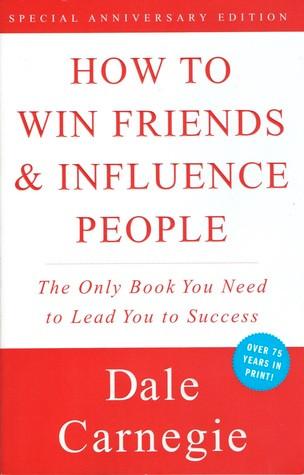Suman Saha's Key Ideas from How to Win Friends and Influence People
by Dale Carnegie
Ideas, facts & insights covering these topics:
27 ideas
·56.7K reads
244
2
Explore the World's Best Ideas
Join today and uncover 100+ curated journeys from 50+ topics. Unlock access to our mobile app with extensive features.
Don’t criticize, condemn or complain
This chapter teaches the first principle of human relations: Don’t criticize, condemn or complain. Criticism hurts people’s pride and makes them resist change. The author gives examples of criminals, Lincoln, and others to show the effects of criticism and understanding. He advises us to improve ourselves, reward good behavior, and appreciate people’s motives. This will help us get along with people better.
718
6.94K reads
Give honest and sincere appreciation
This chapter explains the second principle of human relations: Give honest and sincere appreciation. The author claims that people crave for recognition and praise and that giving them genuine appreciation can win their cooperation and loyalty. He warns against flattery, which is insincere and manipulative. He gives examples of how leaders like Lincoln, Schwab, and Carnegie used appreciation to motivate and influence others. He advises us to look for the good in people and make them feel important.
676
4.6K reads
Arouse in the other person an eager want
This chapter explains the third principle of human relations: Arouse in the other person an eager want. The author argues that people are motivated by their own desires, not by ours and that we can influence them by showing them how our proposal benefits them. He gives examples of how to use this principle in sales, business letters, negotiations, and personal situations. He advises us to ask ourselves: “How can I make this person want to do it?” and to appeal to their interests and needs.
673
4.12K reads
Become genuinely interested in other people
This chapter introduces the first principle of human relations: Become genuinely interested in other people. The author argues that people are not interested in us, but in themselves, and that the only way to win their friendship and influence is to show sincere interest in them and their affairs. He gives examples of how this principle works in sales, business letters, social situations and personal relationships. He advises us to cultivate a curiosity and enthusiasm for people and to ask ourselves: “What is there about him or her that I can admire?”
674
3.3K reads
Smile
This chapter introduces the second principle of human relations: Smile. The author explains that a smile is a simple but powerful way to show friendliness, warmth, and interest in others. He cites examples of how a smile can make people more attractive, more persuasive, and more successful. He also gives tips on how to smile sincerely and genuinely, even when feeling unhappy or stressed. He suggests that smiling can improve one’s mood and attitude, as well as the mood and attitude of others. He concludes that a smile is a valuable asset that costs nothing but creates much.
652
2.73K reads
Remember that a person’s name is to that person the sweetest and most important sound in any language
This chapter introduces the third principle of human relations: Remember that a person’s name is to that person the sweetest and most important sound in any language. The author explains that remembering and using people’s names is a powerful way to make them feel valued, respected, and important. He gives examples of how successful leaders, politicians, and businessmen have used this skill to win friends and influence people. He also gives tips on how to remember names and avoid forgetting them. He concludes that remembering names is a key to success in any field of endeavor.
665
2.68K reads
Be a good listener. Encourage others to talk about themselves
The author explains that most people are more interested in their own lives and opinions than in anything else and that they appreciate someone who listens attentively and sympathetically to them. He gives examples of how successful people have used this skill to win friends and influence people. He also gives tips on how to show genuine interest, avoid interruptions, and make the other person feel important. He concludes that being a good listener is one of the easiest and most effective ways to make a good impression and build rapport with others.
653
2.39K reads
Talk in terms of the other person’s interests
The author explains that people are more likely to listen and respond positively to someone who shows an interest in what they care about. He gives examples of how famous leaders like Theodore Roosevelt and Franklin D. Roosevelt used this skill to win the respect and admiration of others. He also gives tips on how to research and discover the interests of the people you want to talk to. He concludes that talking in terms of the other person’s interests is one of the best ways to make a good impression and build rapport with others.
660
2.25K reads
Make the other person feel important - and do it sincerely
The author explains that people have a deep need to feel valued and appreciated and that one of the quickest ways to make someone like you is to show genuine interest and admiration for them. He gives examples of how famous people like Andrew Carnegie, and Franklin D. Roosevelt used this skill to win the loyalty and cooperation of others. He also gives tips on how to use praise, appreciation, and encouragement effectively and sincerely. He concludes that making the other person feel important is one of the most powerful ways to make a lasting impression and influence people positively.
647
1.99K reads
The only way to get the best of an argument is to avoid it
The author explains that arguing with people is futile and harmful because it makes them defensive, resentful, and stubborn. He gives examples of how famous people like Abraham Lincoln, Benjamin Franklin, and Socrates avoided arguments and used tact and diplomacy instead. He also gives tips on how to handle disagreements gracefully and respectfully, such as listening first, finding areas of agreement, admitting mistakes, and postponing action. He concludes that avoiding arguments is a better way to influence people than trying to prove them wrong.
657
2K reads
Show respect for the other person’s opinions. Never say, ‘You’re wrong.’
The author explains that telling someone they are wrong is a sure way of making enemies and arousing resentment. He gives examples of how successful people like Benjamin Franklin, Socrates, and Charles Schwab avoided arguments and showed respect for others’ views. He also gives tips on how to disagree diplomatically and tactfully, such as using phrases like “I may be wrong” or “It appears to me”. He concludes that respecting others’ opinions is a better way to influence people than trying to show them they are wrong.
647
1.85K reads
679
2.45K reads
If you are wrong, admit it quickly and emphatically
The author argues that admitting one’s mistakes is a sign of courage and honesty, and it can prevent arguments and resentment. He gives examples of how people like Abraham Lincoln, a businessman named Warren, and a Confederate general named Lee admitted their errors and gained respect and sympathy from others. He also gives tips on how to admit one’s faults gracefully and sincerely, such as using humor or self-criticism. He concludes that admitting one’s wrongs is a powerful way to influence people and build trust.
643
1.69K reads
Get the other person saying “yes, yes” immediately.
The author explains that people are more likely to agree with you if you start with points of common interest and avoid direct contradiction. He illustrates this principle with the example of Socrates, who used skillful questioning to lead his opponents to his conclusions. He also gives practical tips on how to apply this principle in business and personal situations, such as finding out what the other person wants, asking questions that elicit a positive response, and postponing action until both sides are in a cooperative mood.
649
1.78K reads
Let the other person do a great deal of the talking
The author explains that people who have a grievance or a complaint want to be heard and understood. By listening patiently and sympathetically, you can let them vent their emotions and calm down. You can also learn more about their situation and their point of view. The author gives examples of how this principle helped salespeople, managers, and spouses to deal with difficult customers, employees, and partners. He also warns against interrupting, arguing, or contradicting the other person while they are talking.
648
1.57K reads
Try honestly to see things from the other person’s point of view.
The author explains that people are more likely to cooperate and accept our ideas if we show them respect and empathy. He suggests that we avoid telling people they are wrong or giving orders, and instead ask questions that let them discover the truth for themselves. He gives examples of how this principle helped a sales manager, a lawyer, a teacher, and a parent to get cooperation from others. He also quotes Socrates, Galileo, and Benjamin Franklin to illustrate the power of this approach.
635
1.4K reads
Be sympathetic with the other person’s ideas and desires
you should try to understand and respect the other person’s feelings and goals, even if they are different from yours. You should avoid judging, arguing, or dismissing their ideas and desires, and instead show that you care about them and their perspective. This will help you build rapport, trust, and cooperation with the other person, and make them more open to your ideas and suggestions. Being sympathetic with the other person’s ideas and desires is one of the principles of winning people to your way of thinking, according to Dale Carnegie.
638
1.34K reads
Appeal to the nobler motives
This chapter explains how to appeal to the nobler motives of people when trying to persuade them to do something. It argues that people are more likely to respond positively if they feel that they are acting for a good cause, rather than for selfish or petty reasons. The chapter gives examples of how leaders like Abraham Lincoln, Charles Schwab, and Henry Ford used this principle to motivate their followers, employees, and customers. It also suggests some phrases that can be used to appeal to the nobler motives of people, such as “I don’t doubt that you want to do what is fair and right.”
634
1.32K reads
Throw down a challenge
This chapter explains how to motivate people to do their best by appealing to their competitive spirit and desire for achievement. It argues that people are often bored and uninterested in their work or tasks, and need a challenge to arouse their enthusiasm and creativity. The chapter gives examples of how Charles Schwab, Andrew Carnegie, and other successful leaders used challenges to inspire their workers and associates to accomplish extraordinary results. The chapter also suggests some ways to create challenges, such as setting high goals, offering rewards, or stimulating friendly rivalry.
635
1.28K reads
Begin with praise and honest appreciation
This chapter advises how to criticize someone without offending them or hurting their pride. It suggests that before pointing out a mistake or a flaw, you should start with a sincere praise or appreciation for something good that the person has done. This will make them feel valued and respected, and more willing to accept your feedback. The chapter gives examples of how famous leaders like Abraham Lincoln, Napoleon, and Ralph Waldo Emerson used this technique to correct their subordinates, friends, and family members.
639
1.19K reads
Call attention to people’s mistakes indirectly
This chapter teaches how to give constructive criticism without arousing resentment or anger. It recommends using some techniques such as beginning with praise, calling attention to mistakes indirectly, talking about your own mistakes, asking questions instead of orders, letting the other person save face, praising every improvement, giving a fine reputation to live up to, using encouragement, and making the other person happy about doing what you suggest. The chapter illustrates these techniques with examples from various fields and situations, such as business, education, and family life.
638
1.25K reads
Talk about your own mistakes before criticizing the other person
This chapter explains how to admit your own mistakes before criticizing the other person. It argues that this will make the other person feel less defensive and more willing to listen to your feedback. It also shows that you are humble and honest and that you have high standards for yourself and others. The chapter also warns against using insincere or exaggerated confessions, as that would only backfire and damage your credibility.
633
1.15K reads
Ask questions instead of giving direct orders
This chapter advises how to avoid giving direct orders that may offend or provoke resistance from the other person. It suggests using questions or suggestions instead of commands and letting the other person feel that he or she has some choice or control over the situation. The chapter gives examples of how leaders like Henry Ford, Ralph Waldo Emerson, and Abraham Lincoln used this technique to influence their workers, friends, and generals. The chapter also explains why this technique works, based on the psychological principle of respect for the other person’s ego.
634
1.13K reads
Let the other person save face
This chapter teaches how to avoid hurting the other person’s pride or dignity when you have to correct or criticize them. It argues that humiliating or embarrassing the other person will only make them resentful and hostile, and damage your relationship. It suggests using tact and diplomacy, and giving the other person a chance to explain or justify themselves. The chapter gives examples of how leaders like Confucius, Benjamin Franklin, and J. P. Morgan used this technique to deal with their opponents, rivals, and partners.
629
1.11K reads
Praise the slightest improvement and praise every improvement. Be “hearty in your approbation and lavish in your praise
This chapter advises how to change people’s behavior and attitude by changing their labels or nickname. It suggests using positive and flattering names that imply desirable qualities, such as “the best salesman in the office” or “the most reliable worker in the team”. The chapter gives examples of how leaders like Al Capone, George Eastman, and Abraham Lincoln used this technique to influence their gangsters, employees, and generals. The chapter also explains why this technique works, based on the psychological principle of suggestion.
632
1.08K reads
Use encouragement. Make the fault seem easy to correct
This chapter teaches how to avoid discouraging or demoralizing the other person when you point out their mistakes or shortcomings. It recommends using encouragement and optimism, and making the other person feel that the fault is minor and easy to fix. The chapter gives examples of how leaders like Thomas Edison, Harvey Firestone, and J. Pierpont Morgan used this technique to deal with their inventors, mechanics, and bankers. The chapter also explains why this technique works, based on the psychological principle of motivation.
633
994 reads
Make the other person happy about doing the thing you suggest
This chapter explains how to persuade and influence people to do what you want them to do, without using coercion or threats. It suggests using positive reinforcement, such as praise, appreciation, and rewards, and appealing to the other person’s noble motives, such as fairness, justice, and goodwill. The chapter gives examples of how leaders like Franklin D. Roosevelt, Woodrow Wilson, and Andrew Carnegie used this technique to win over their opponents, allies, and employees. The chapter also explains why this technique works, based on the psychological principle of reciprocity.
627
1.03K reads
IDEAS CURATED BY
A learner who loves to share wisdom on personal growth, happiness, and success on Deepstash. Topics include motivation, habits, goals, and mindset. Believes that everyone can achieve their dreams with the right attitude and action.
CURATOR'S NOTE
This book shows the importance of avoiding criticism and understanding human nature in dealing with people. It also gives some suggestions on how to get the most out of reading the book, such as reviewing it frequently, applying the principles in daily life, and keeping a record of one’s progress. The web page aims to persuade the reader that mastering the art of human relations can lead to a richer, fuller, happier, and more fulfilling life.
“
Curious about different takes? Check out our How to Win Friends and Influence People Summary book page to explore multiple unique summaries written by Deepstash users.
Different Perspectives Curated by Others from How to Win Friends and Influence People
Curious about different takes? Check out our book page to explore multiple unique summaries written by Deepstash curators:
15 ideas
1 idea
PRIYANSHU MAHESHWARI's Key Ideas from How to Win Friends and Influence People in the Digital Age
Dale Carnegie & Associates
Discover Key Ideas from Books on Similar Topics
3 ideas
29 ideas
Public Speaking for Success
Dale Carnegie, Arthur R. Pell
8 ideas
Charisma on Command
Charlie Houpert
Read & Learn
20x Faster
without
deepstash
with
deepstash
with
deepstash
Personalized microlearning
—
100+ Learning Journeys
—
Access to 200,000+ ideas
—
Access to the mobile app
—
Unlimited idea saving
—
—
Unlimited history
—
—
Unlimited listening to ideas
—
—
Downloading & offline access
—
—
Supercharge your mind with one idea per day
Enter your email and spend 1 minute every day to learn something new.
I agree to receive email updates









